7. Noise Processing
This topic covers the following noise-processing topics:
- System Impulse Response Correction (SIRC)
- Noise Preserving Filters
- The Random Noise Operator
- Jitter-Mode Noise Processing
- Error Messages
System Impulse Response Correction (SIRC)
FlexDCA's SIRC feature allows the channel response to be corrected with a digital filter. A channel that allows SIRC is one that has been measured or characterized in both magnitude and phase. The following two figures show the configuration dialogs for SIRC for both optical and electrical channels. The dialog's options (fields) are described in this section.
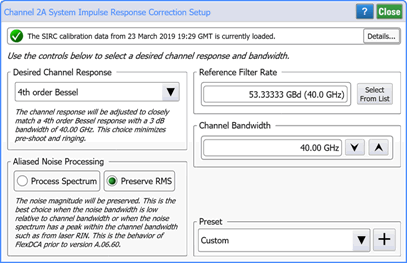
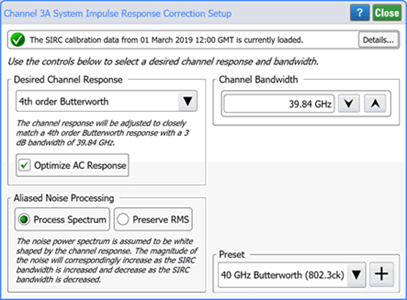
Desired Channel Response Option
The Desired Channel Response options refer to the desired channel frequency response after correction. The following sections describe the choices available, and the following figure compares the spectral magnitude responses.
4th order Bessel
This is the response of typical optical reference receiver. For NRZ standards the cutoff frequency is usually set to 75% of the symbol rate while for PAM4 TDECQ measurements the frequency is set to 50% of the symbol rate. The 4th order Bessel response is a causal filter that has minimal ringing and inter-symbol interference.
Sin(x)/x (Brick Wall)
The sin(x)/x or brick wall response is the typical response of a real-time scope. It fully captures the behavior of a band-limited signal provided that the test signal’s bandwidth is less than the specified response bandwidth. If the spectrum of the signal is not fully contained within the selected response bandwidth, this response will introduce ringing and non-causal artifacts. This is typically used within FlexDCA to correlate measurements with real-time oscilloscopes.
Butterworth
The 1st, 2nd, 3rd, and 4th order Butterworth filter options are useful when the scope response is required to match a reference receiver response with the same shape. For example, IEEE 802.3ck specifies a 4th order Butterworth response.
Flat
The flat correction does perfect magnitude and phase correction out to the desired bandwidth, just like the Brick Wall response. However, instead of rolling off at that frequency, the correction is gradually reduced to follow the response of the channel. This generally will maximize the available bandwidth while minimizing the introduction of non-causal effects for signals that are not fully band-limited.
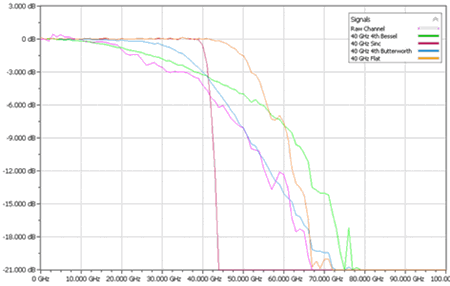
| Channel Legend |
|---|
| Raw Channel |
| 40 GHz 4th Bessel |
| 40 GHz Sinc |
| 40 GHz 4th Butterworth |
| 40 GHz Flat |
Reference Filter Rate & Channel Bandwidth
The Reference Filter Rate setting is only available for optical channels and only when the channel response is set to Bessel. This allows you to select a symbol rate instead of a bandwidth value. The channel bandwidth is always available.
However, note that the relationship between symbol rate and bandwidth is not one-to-one. There are multiple rates that map to the same bandwidth and multiple bandwidth that map to the same rate. For example, the symbol rate 26.5625 GBd has four different bandwidths that may be associate with it:
- 19.34 GHz is the bandwidth for NRZ mask measurements,
- 12.6 GHz is the bandwidth for NRZ TDEC measurements,
- 13.28 GHz is the bandwidth for PAM4 TDECQ measurements in single-mode fiber, and
- 11.2 GHz is the bandwidth for PAM4 TDECQ measurements in multi-mode fiber
Going the other direction, there are multiple symbol rates that map to the same bandwidth. For example, 19.34 GHz is the correct 3 dB bandwidth for both:
- 25.78125 GBd (NRZ), and
- 26.5625 GBd (NRZ)
This lack of correspondence can make remote programming difficult. However, problems will be minimized if the following rules are followed:
- For NRZ mask/eye testing, set the symbol rate using the
:CHAN:SIRC:FRATeSCPI command. - For TDECQ and TDEC testing, set the bandwidth using the
:CHAN:SIRC:FBANndwidthSCPI command.
FlexDCA's SCPI Recorder properly reports the preferred syntax based on the filter selected.
Aliased Noise Processing
The Aliased Noise Processing field has two settings: Preserve RMS and Process Spectrum.
Preserve RMS
Preserve RMS will preserve the magnitude of the noise. This is the best choice when the spectrum of the noise has a significant peak within the bandwidth of the channel or when an uncorrelated but deterministic signal is known to be present on the signal. An example of this is laser RIN (Relative Intensity Noise) which typically has a peak below the modulation bandwidth. The following figure shows an example of RIN measured for various conditions of the laser. The measurements are from the Keysight A0010A RIN measurement system.
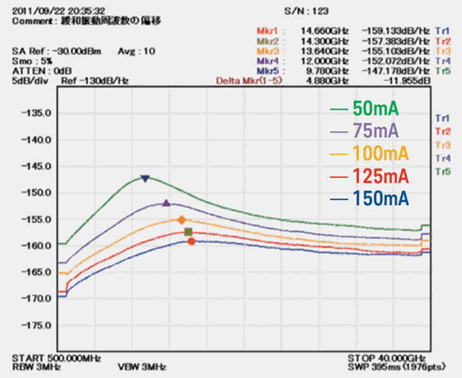
Another instance where Preserve RMS is appropriate is when low frequency interference is present on the signal due to cross talk or intentional closure in stressed eye testing.
Process Spectrum
The other aliased noise processing option is Process Spectrum. This option assumes that the aliased (uncorrelated to the trigger) signal components have the same power spectrum as the measurement channel. In this case, if SIRC is reducing bandwidth the magnitude of the noise on the output signal will be correspondingly reduced, whereas if SIRC is increasing bandwidth the magnitude of the noise will be increased.
In many cases the difference between Preserve RMS and Process Spectrum will be slight. For example, optical modules generally provide reference filter selections that are compliant with a tolerance window. Even though they are compliant, there still can be phase and magnitude variations from an ideal 4th order Bessel shape. SIRC can dramatically improve channel-to-channel correlation of measurements like mask margin even while making only slight modifications to the power spectrum of the measured signal. In this common situation, it will make little difference which noise processing option is selected.
The situation where noise needs to be carefully considered is when SIRC is used to significantly increase or decrease the bandwidth of the module.
Optimize AC Response
The 86108B module provides an additional checkbox labeled Optimize AC Response. This module has a slightly different AC response than DC response. Because the module is calibrated to a DC voltage standard, this means that the accuracy of some vertical eye measurements can be degraded. For example, Eye Height when expressed in units of volts will have a systematic error. Eye height in units of ratio or unit amplitude will not have this error.
The Optimize AC Response selection will correct for this error, although it will do so by sacrificing DC accuracy. When measuring differential signals or AC coupled signals, this is an appropriate tradeoff to make.
Noise Preserving Filters
None Selection
The option
Process Spectrum Selection
The option
The default behavior of the Process Spectrum noise processing option is to use the noise power spectrum of the input signal. If the input signal is a sampling scope channel with SIRC active, this spectrum will be established by the measured hardware response of the channel. For other channels, the response will be assumed Gaussian with a 3 dB frequency corresponding to the nominal channel bandwidth. This behavior can be overridden by clearing the Track Input Response checkbox and manually entering a bandwidth. If this option is utilized the response will be presumed Gaussian with the selected 3 dB bandwidth.
Preserve RMS Selection
The option
By tracking the accumulated effects of the filtering operations, accurate noise processing can be done even when chaining operations as illustrated in the following figure. In addition to the sampled waveform, information about the acquisition channel and noise power spectrum are maintained in each signal and appropriately processed by each filter. The complete set of auxiliary information is also included when storing FlexDCA waveforms in the *.wfmx file format.
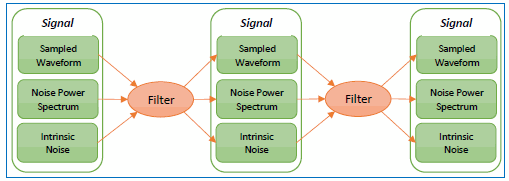
The Random Noise Operator

The random noise operator has a variety of options for simulating noise as shown in this figure of the Random Noise/Jitter Setup dialog. The following sections discuss the benefits and considerations of these options.
White Noise
When white noise is selected, an independent Gaussian-distributed random value is added to each sample in the waveform. The magnitude of the noise is specified as an RMS value in the units of the input signal. This noise appears on the waveform the same way that signal noise would appear on an equivalent-time waveform. As shown in the following FlexDCA Waveform Processing figure, the intrinsic noise will not be modified by the random operator. Therefore, any measurement that backs out the intrinsic noise of the instrument will not back out any noise added by the operator. In addition, the noise power spectrum will not be modified. Therefore, any following filter operations will treat this noise as if it has the same power spectrum as the noise on the input (typically the channel bandwidth).

Bandwidth Limited, RMS Defined
When Bandwidth Limited noise in the dialog is selected, the magnitude of the noise may be specified either as a total RMS value (RMS selection) or as a power-per-frequency (η0), the Spectral Density selection. The difference between white noise and bandwidth-limited noise is illustrated in the following figure. While both noise sequences shown in the figure have the same RMS value, the bandwidth limited sequence has a degree of correlation between the samples. This is non-aliased noise like you would measure if a real-time oscilloscope were used to capture the noise sequence.

The default behavior for bandwidth limited noise is to make the noise spectrum track the input spectrum. So, if the input to the operator is a channel with SIRC active and a 4th order Butterworth response, then the noise added will also have a 4th order Butterworth response. If the input is a CTLE with 6 dB of gain, then the noise will match the same 6 dB CTLE response. Just like in the white noise case, in this situation the intrinsic noise and the noise power spectrum will not be modified.
The noise bandwidth can alternatively be specified as a Gaussian response. In this case, the noise will have the specified bandwidth with a Gaussian roll off and the noise power spectrum of the output signal will be correspondingly modified.
Bandwidth Limited, Spectral Density Defined
The per-frequency spectral designation of bandwidth-limited noise is useful when modeling real receivers where the noise power scales with the bandwidth. It is also used to specify reference noise by some standards such as IEEE 802.3ck. When defining noise using the Spectral Density designation, an approximation of the RMS magnitude of the noise can be made as where f is the noise bandwidth. However, this is just an approximation as the actual value will depend on the shape of the input response (for example, Bessel versus Butterworth versus Brick Wall).
This method of specification has the interesting property that in many cases it doesn’t matter whether the noise is added before or after a filtering operation. For example, imagine that band-limited noise is added to a 40 GHz channel and then filtered with a 10 GHz filter. The RMS magnitude of the noise added will be approximately . After applying the 10 GHz filter, the RMS noise will be filtered and reduced by a factor of 2 yielding an RMS value of
. But this is the same magnitude of noise that would have been added if the noise had been added after the 10 GHz filter:
.
Although in that example it does not matter, there are situations where order does matter. For example, consider a simple gain block that doubles the signal. If the noise block is added before the gain block, the noise magnitude will also be doubled by the gain block while it would not be doubled if the noise block is instead placed after the gain block. In most situations, it is best to add the noise as early as possible in the signal processing chain to avoid any ambiguities that otherwise may arise from differential operators, non-linear operators, or filters that do not have unity DC gain.
Random Jitter
As of FlexDCA version 6.60, only jitter with white spectral properties can be added to a waveform.
Jitter-Mode Noise Processing
FlexDCA’s Jitter Mode analysis works by acquiring targeted samples to characterize the various components of jitter, noise, and interference as quickly as possible. When analyzing noise, jitter mode works by finding a region of the signal that has the correct symbol level yet minimal slope. A large number of samples are taken in this region and then spectral and/or statistical techniques are used to characterize the noise. Filters and other signal processing operations are applied to the power spectral density function of the noise in order to determine the correct magnitude of the noise and interference components after processing.
Intrinsic Noise Removal
FlexDCA allows automatic compensation of the channel’s intrinsic noise. Every time a DCA channel is calibrated the user is required to disconnect all signals from the channel. When this is done, FlexDCA measures and stores the amount of channel noise for each channel bandwidth/filter. This noise can then be removed from the measurements so that only the signal noise is reported. To enable intrinsic noise removal, select the appropriate RN Compensation value from the Advanced tab of the Jitter Mode Measurement Setup dialog, as shown in the following figure. When this feature is active, the amount of intrinsic noise that is being removed is reported in the measurement results area. Note that if the intrinsic noise is large compared to the signal noise, the accuracy of the measured noise will be reduced. Also note that the value of intrinsic noise reported is the value after applying the signal processing operations. By way of example, if a channel has 1 mV of intrinsic noise but an Amplify signal processing operator is used with a scale factor of 2.0, then the amount of intrinsic noise that will be removed is 2 mV.
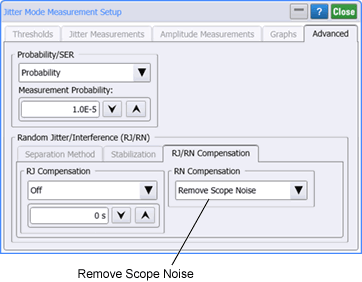
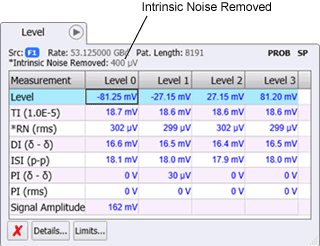
Because the noise is measured during calibration, it is important that signals be fully disconnected from the channel during calibration. Some sources may continue to inject noise or offsets even when their outputs are nominally disabled. This may increase the amount of noise measured during calibration and thereby cause FlexDCA to remove more noise than is actually intrinsic to the channel.
Reference Receivers with Noise
Some standards, such as IEEE 802.3ck, call out a reference receiver with a specific frequency response and a specific amount of noise. This can be achieved in Jitter Mode using the Random Noise signal processing operator along with the Remove Intrinsic Noise feature described above. These two features will work together such that just the right amount of noise is added or removed to attain the noise indicated in the configuration of the Random Noise operator. A typical configuration for 802.3ck is shown in the following figure. The input to this chain should be a differential electrical channel with SIRC enabled and set to a 4th order Butterworth response with 39.84 GHz bandwidth. Electrical SIRC, the Random Noise operator, CTLE, and DFE all have presets to select the correct configuration for the standard. When combined with the “Remove Scope Noise” feature the precise amount of noise can be included in the measurement analysis to comply with the standard. Note that there is also a setup file in the \Demo folder that has the correct setup for IEEE 802.3ck Eye Opening measurements using an N1060A module.
C:\Program Files\Keysight\FlexDCA\Demo\Setups\Demo\IEEE\IEEE_802.3ck_Eye_Opening_N1060A_N1000A.setx
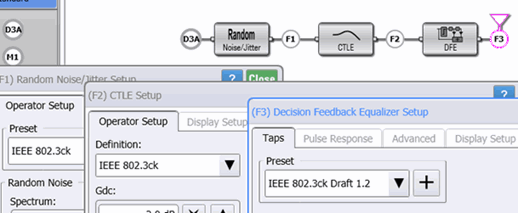
For this case of a reference receiver with defined noise, FlexDCA may need to add noise or it may need to remove noise, but it will not do both. If the intrinsic noise of the instrument exceeds the desired amount of noise specified by the Random Noise operator, then the Random Noise operator will not add any noise and instead the correct fraction of the intrinsic noise will be removed such that the desired reference noise is obtained. On the other hand, if the noise specified by the Random Noise operator exceeds the intrinsic noise, then the Random Noise operator will only add enough noise to bring the total up to the desired value. This is indicated by the “Intrinsic Noise Remove” value shown in the Level results panel that is shown in the figure Jitter mode allows removal of intrinsic noise above. If the desired noise exceeds the intrinsic noise, then the value of noise removed will be indicated as zero. On the other hand, if the intrinsic noise exceeds the desired noise then the amount of noise actually removed will be indicated.
Error Messages
Insufficient Samples/UI
- Additional Message Text
- The source waveform has not been acquired with enough samples/UI to accurately represent noise
Unknown Bandwidth
- Additional Message Text
- The input bandwidth for the signal is unknown. Noise will not be represented properly on the resulting waveform
- Solution
- The input bandwidth is needed for two reasons. First, the bandwidth will be used to establish the power spectral density of the noise if Track Input Spectrum is enabled. Second, the bandwidth is needed to establish the frequency in the equivalent-time spectrum above which only aliased components are present. The bandwidth is usually known, but if the source is a memory (imported data from *.txt or *.csv format), the bandwidth may have been omitted.
Unable to accurately represent noise
- Additional Message Text
- Unable to accurately represent noise on the processed waveform. This may indicate insufficient samples per UI or it may indicate that not all operations in the waveform signal processing path have Preserve Noise properly configured.
- Solution
- This typically indicates a chain of operators where not all filters have noise preservation enabled or there is a conflict in the configuration, such as an explicitly specified noise bandwidth that is too high. Check the configuration of the operations to verify that the noise handling options are correctly specified. If they are, then increasing the samples per UI may address the issue.
The intrinsic noise is larger than the measured noise
- Solution
- This situation can arise if the module calibration is required due to significant temperature drift or if the module calibration was performed with a signal connected. Disconnect all signals and perform calibration.
The intrinsic noise for this signal is unknown
- Solution
- Intrinsic noise is known for scope channels and memory waveform that were saved from scope channels. Waveforms from other sources may not include an intrinsic noise term. In this situation, the noise cannot be removed.